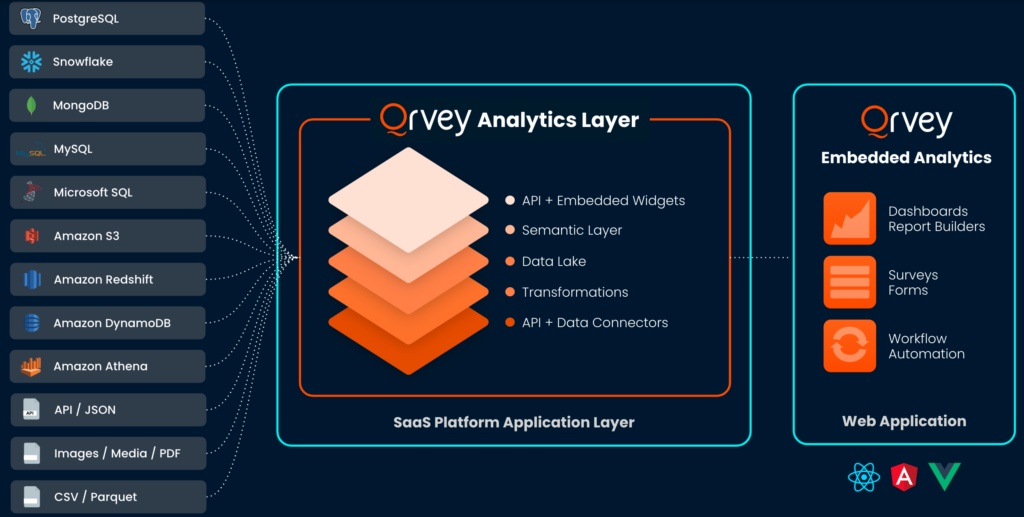Intro to Qrvey
The Qrvey platform is an all-in-one analytics solution that enables SaaS providers to quickly put analytics in the hands of their users.
How it Works
With Qrvey, take your analytics from zero-data to embedded in a few steps:
- Launch the Qrvey Platform – Powered by Docker and Kubernetes, you can run it on your preferred supported cloud provider.
- Connect Your Data – The platform supports a wide range of databases and sources for your data pipeline, including SQL, NoSQL, data lakes, CSV, JSON, and APIs.
- Create Datasets – Transform, combine, synchronize, and set permissions on data to help generate analytics.
- Build Dashboards – Use Qrvey's drag-and-drop features to tailor interactive, customizable dashboards for your SaaS organization and end users.
- Embed and Go – Copy and paste dashboards straight into your app in minutes.
Qrvey provides the following additional benefits:
- Pixel-Perfect Reports – Generate polished, data-driven reports.
- Automated Workflows – No-code, automated workflows.
- Content Deployment – Move Qrvey data and content to suit your business needs.
- Granular Roles and Permissions – Control access for your Saas team and your end users.
Qrvey Components
Qrvey's core components address specific roles in your embedded analytics workflow:
- Qrvey Composer — A no-code/low-code app for your Saas team to build and manage the platform.
- Qrvey Admin Center — Consolidated controls to configure, manage, and monitor the Qrvey environment.
- Data Engine — A powerful data engine to handle data ingestion to power end-user analytics.
- Embedded Analytics Widgets — Flexible modules to embed and configure analytics dashboards in your SaaS app.
Qrvey Platform Architecture
The following architecture diagram shows how Qrvey's analytics layer can use a range of data sources to generate embedded analytics for your organization.

Platform Tiers
Choose the version of Qrvey that fits your team:
- Qrvey Pro – For teams with ready-to-query data and data sources, and a straightforward need for embedded dashboards.
- Qrvey Ultra – Comprehensive solution that includes our Elasticsearch data lake and ETL transformations.
| Features | Qrvey Pro | Qrvey Ultra |
|---|---|---|
| Live Connect Datasets | ✅ | ✅ |
| Managed Datasets (Elasticsearch) | ❌ | ✅ |
| Dataset Transformations | ❌ | ✅ |
| Content Deployment | ✅ | ✅ |
| Dashboards & Charts | ✅ | ✅ |
| Automated Workflows | ✅ | ✅ |
| All Other Features! | ✅ | ✅ |
Qrvey's Customers
Qrvey can meet the needs of any SaaS company, regardless of data type, source, or model. It empowers your organization to deliver dashboards and analytics within your app, without the time, cost, and complexity of building data infrastructure, pipelines, user permissions, middleware, synchronization, and front-end analytics interfaces from scratch.
Your SaaS Team
Your SaaS team includes the following general categories of Qrvey users:
- CloudOps Engineers – Cloud experts that deploy, upgrade, and keep your Qrvey platform operating at peak efficiency.
- Data Engineers – Architects of the data pipelines tailored to your business needs.
- Data Analysts – Business specialists who build datasets and dashboards that deliver insights to your end users.
- Software Developers – Front-end experts that integrate Qrvey’s analytics into your app.
They typically take on one of the following roles:
- Administrators – Manage and monitor the platform infrastructure, such as user access, data routing, Elasticsearch indexing, and deployment between environments. They don’t touch the actual dashboard content — that’s the Creator’s job.
- Creators – Set up datasets and build visualizations and dashboards. Creators might be Data Analysts who use Qrvey Composer or Developers who embed widgets (customizable functionality packages) and APIs directly into front-end applications.
You can also create custom roles and customize permissions based on your team's needs.
Your End Users
These external users — your customers — interact with Qrvey inside your app. You can manage them as individuals or organizations.
- Viewers – The majority of your end users. They view embedded dashboards, charts, and widgets without needing editing rights.
- Power Users – Advanced, hands-on users who create their own dashboards, visualizations, and custom assets using the datasets you provide.
You can combine Qrvey's user management and widget development tools to provide complete row-level and column-level security for each embedded instance of a widget.